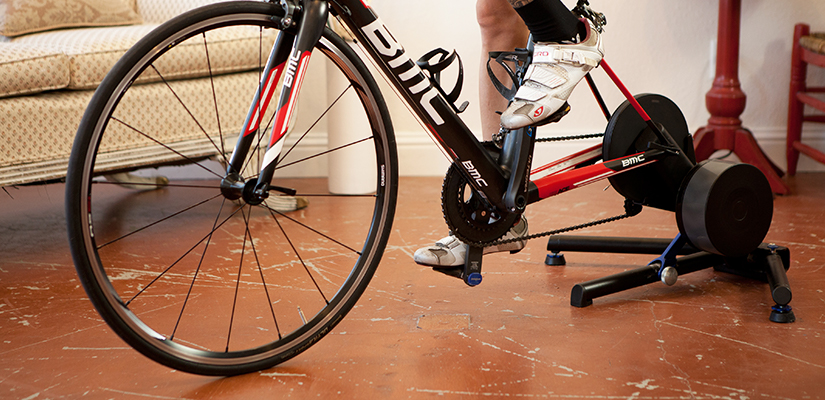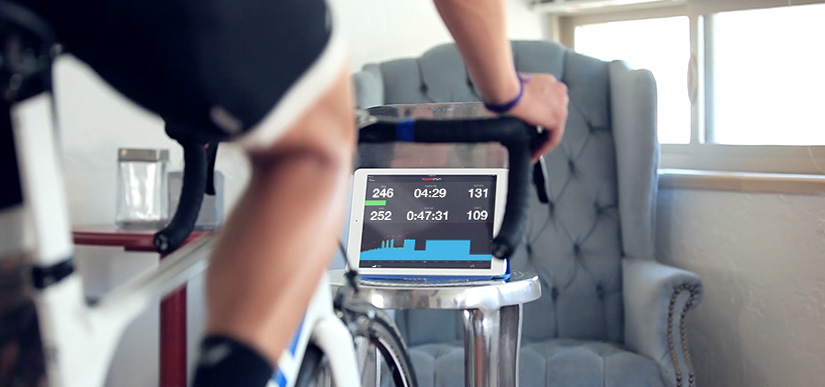Are Smart Trainers Bad for Training and Can They Cause Injuries?

Lately, we’ve been getting an influx in questions about whether smart trainers are bad for your training. Our straightforward answer is no — we’ve actually found the opposite to be true. For athletes who might have concerns about using a smart trainer, in today’s post we’re addressing five questions we’ve been asked recently.
Question #1: Can my smart trainer’s Erg mode affect the outcome of my FTP test?
Smart trainers are famous for something called Erg mode. This allows apps like TrainerRoad to constantly control the resistance of your trainer so no matter what gear you’re in and how quick your cadence is, you are hitting your power target.
Smart trainers also have another mode called Standard mode (aka Slope mode). When you are in this mode, your trainer looks at how fast you are spinning your wheel (or cassette), and tries to emulate the amount of resistance you would feel if you were riding in typical outdoor conditions on a flat road.
When you’re doing an FTP test on a smart trainer, your trainer will automatically switch out of Erg mode and into Standard mode just before you enter a testing interval. This is paramount. Why? Testing in Erg mode prevents you from being able to explore your most accurate and current fitness potential.
The reason that Erg mode limits you is due to the controlled nature of Erg mode. The way your Smart trainer calculates your power output is by measuring how much force you are putting through the drive train and how quickly you are spinning the pedals. In order to maintain a specific power target, your trainer will ease up on the resistance when you start pedaling quicker. The reverse happens when you slow down. When your cadence drops significantly — like right after you finish an intense interval — your trainer will increase its resistance. These adjustments your smart trainer makes are to help you hit your power target, but they don’t allow you to voluntarily increase or decrease your power output.
Having said that, every time you begin a testing interval, TrainerRoad will switch your trainer’s mode from Erg mode to Standard mode. Since Standard mode is using your virtual speed to judge resistance, it’s up to you to shift and change your cadence and force in order to adjust your power output. In short, it allows you to freely pace according to your current capabilities.
If you switch back into Erg mode and increase your intensity during a testing interval in order to put out a specific wattage, this kind of intervention will most likely hinder your ability to get a true assessment of your potential. The point is: You’re always going to be limited in Erg mode — don’t resist the adjustments your smart trainer makes for you. Accept them and understand that the reasoning behind them.
Question #2: Can gearing affect my power output on my smart trainer?
Not really — the reason gearing is less relevant with smart trainers than with traditional trainers is because they have Erg Mode, which we discussed above in question #1. No matter what gear you’re in, Erg mode can adjust your resistance. Compact, closely spread cassettes, whether you have a smart trainer or not, will always provide a better indoor riding experience.
When you train indoors, you want the spacing in between your gears to be very small. This is to prevent big jumps from one gear to the next from causing difficulty to hit your power target at a comfortable cadence. Often times, with bigger cassettes you might have to ride at a cadence that’s either too low or too high to hit your power target. If you have a close-range cassette, like a 12-25, that allows for more micro adjustments.
So if you want to increase your power target by 10 watts, you’re able to shift without risk of either spinning too quickly or too slowly to hit your new mark. That’s the key with closely spaced cassettes — they allow you to make small incremental changes so you can hit your power target with precision.
Most smart trainers have wheel-off designs and a cassette mounted to them. The cassette that comes with your smart trainer may not be the ideal size for indoor training. If it has a wide gearing range we recommend you replace it with a narrow range cassette to get your best performance. If your smart trainer does not have a wheel-off design, we still recommend getting a smaller cassette for the spare wheel you use for indoor training.
The cassettes we use in the office are relatively inexpensive and can be found on Amazon here: Shimano 105 11-Speed Cassette and Shimano 105 10-Speed Cassette. Heads up: SRAM and Shimano cassettes are interchangeable. Campagnolo cassettes, on the contrary, have a unique mounting interface and cannot be used interchangeably.
Rider tip: Wheel-off design or not, in either case, it’s always a good idea to replace your chain and chainrings at the same you replace your cassette, as all generally wear together.
Question #3: Do smart trainers cause injuries?
No (we’ll explain this in a bit). When an athlete gets started on a smart trainer, a somewhat common feeling is that they’re going to get locked into whatever resistance it’s in — and if they can’t hold that resistance, they could be risking an injury. There is a very, very small chance this would ever happen.
Your smart trainer is not going to cause injuries, but how you use it, in rare cases, can. For example, if you ride at a very low cadence — regardless of the type of trainer you’re on — there’s a slight possibility that you could cause excess strain on your muscles. How? Spending any long duration of time at an extremely low cadence, like sub 40 RPM, will result in your smart trainer applying a lot of resistance. This will happen when it’s trying to help hold your power target. In a situation like this, pedaling will become extremely difficult. The force you experience will be strong, but in 99.9% of cases it won’t be so much that it would cause an injury.
Question #4: Do smart trainers increase my cadence?
Not really — remember that a major perk of a smart trainer is that you can pick your own cadence at whatever power target you’re shooting for. This is the case for everyone. However, we do hear about some athletes claiming a reasonable increase in cadence on their smart trainer, which certainly isn’t a bad thing.
This is caused by the trade off between force and speed that a smart trainer is constantly adjusting when holding you to your power target. We generally like to avoid high force efforts, so while riding at a power target we subconsciously increase our cadence to decrease how much force we are having to put out. Once again, this isn’t a bad thing. We generally see people increasing their cadence up into the 85-100RPM range.
All that said, you can still pedal at whatever cadence you choose. If you use a smart trainer for the first time and you already have good cadence, nothing is going to change for you. However, if your cadence is not the best, what we’ve always found is that your smart trainer will help put you in the proper cadence range — not too high, not to low.
Question #5: Do smart trainers eliminate the need for a wheel block?
Yes — but you can keep using yours if it makes riding more comfortable. When transitioning from a regular trainer to a smart trainer, many athletes will implement their same set up to a tee, including their wheel block. This is not always necessary because some smart trainers have height adjustments on them, thus eliminating the need for a wheel block.
Don’t throw your wheel block away just yet. Although you might not technically need a wheel block, some athletes still prefer to ride with one because it puts them slightly higher up. Even though we don’t entirely notice it, on the road there’s wind pushing against us, relieving pressure we have on our hands and wrists. When you don’t have any of that heavy wind, it’s likely you’ll notice more weight on your bars when you train inside. By shifting your weight back from your hands to your sit bones, a wheel block can help make you more comfortable
Final Words
Smart trainers are not bad for training. In fact, we think they’re giving a lot more riders access to higher quality workouts. Before smart trainers with wheel-off designs came along mountain bikers, for instance, didn’t have an easy solution if they wanted to train indoors. They had to buy road tires for their mountain bikes so they could use a trainer. The whole thing was a pain in the neck. Smart trainers now, like the Wahoo Kickr that comes with a handy thru-axle adapter, are making effective indoor training more accessible to a wider range of riders. That’s something we can get behind.
Listen to Certified Cycling Coaches Discuss Smart Trainers
“Are smart trainers bad for training?” is one topic we covered in episode 20 of the Ask a Cycling Coach podcast. Listen to the episode’s full recording below to hear this and other questions from cyclists get answered by our certified cycling coaches.
Additional Notes
TrainerRoad’s Ask a Cycling Coach podcast is dedicated to making you a faster cyclist. It gives you the chance to get answers to your cycling and triathlon training questions from USAC certified coaches Chad Timmerman, Jonathan Lee and special guests. Learn more about other topics we covered in the latest episode with our resources below:
• How to train for a triathlon with TrainerRoad
• What time of day is the best time to train?
• Does bike geometry affect power output?
• Can you compare power from one cyclist to another?
• Does running make you a slower cyclist?
• How to take an FTP test?
• Using ERG mode during an FTP test?
• What is the best gearing for indoor training?
• Do electronic trainers increase your cadence?
• How to quantify cross-training for cycling
• How to use walking for recovery and training for cyclists
• Do electronic trainers cause injuries?
• Are smart trainers detrimental?
• How to improve core strength for cycling
• Does old age affect FTP and VO2 Max
• How to adjust your training for old age
If you have a question that you’d like to ask Coach Chad, submit your question here. We’ll do our best to answer them on the next episode of the Ask a Cycling Coach podcast.
